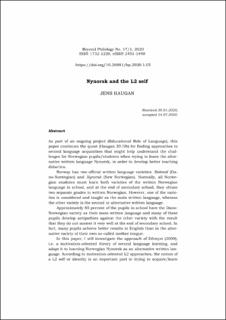| dc.contributor.author | Haugan, Jens | |
| dc.date.accessioned | 2021-04-19T07:55:48Z | |
| dc.date.available | 2021-04-19T07:55:48Z | |
| dc.date.created | 2021-02-01T13:00:40Z | |
| dc.date.issued | 2020 | |
| dc.identifier.citation | Beyond Philology. 2020, 17 (1), 123-157. | en_US |
| dc.identifier.issn | 1732-1220 | |
| dc.identifier.uri | https://hdl.handle.net/11250/2738247 | |
| dc.description | All articles available under Attribution 4.0 International (CC BY 4.0). | en_US |
| dc.description.abstract | As part of an ongoing project (Educational Role of Language), this paper continues the quest (Haugan 2019b) for finding approaches to second language acquisition that might help understand the challenges for Norwegian pupils/students when trying to learn the alternative written language Nynorsk, in order to develop better teaching didactics. Norway has two official written language varieties: Bokmål (Dano-Norwegian) and Nynorsk (New Norwegian). Normally, all Norwegian students must learn both varieties of the written Norwegian language in school, and at the end of secondary school, they obtain two separate grades in written Norwegian. However, one of the varieties is considered and taught as the main written language, whereas the other variety is the second or alternative written language. Approximately 85 percent of the pupils in school have the DanoNorwegian variety as their main written language and many of these pupils develop antipathies against the other variety with the result that they do not master it very well at the end of secondary school. In fact, many pupils achieve better results in English than in the alternative variety of their own so-called mother tongue. In this paper, I will investigate the approach of Dörnyei (2009), i.e. a motivation-oriented theory of second language learning, and adapt it to learning Norwegian Nynorsk as an alternative written language. According to motivation-oriented L2 approaches, the notion of a L2 self or identity is an important part in trying to acquire/learn a second language. I will claim that this part of language learning is crucial in the understanding of the challenges connected with learning Norwegian Nynorsk as an alternative language. Most language learners would be more motivated to acquire a second language than trying to have a second identity connected to a variety of the same language. Since the content of this paper is a continuation and extension of the previous work in the same research project and network and I consider the general background crucial for the argumentation, certain parts of the presentation are borrowed or adapted from Haugan (2019b). | en_US |
| dc.language.iso | eng | en_US |
| dc.relation.uri | https://fil.ug.edu.pl/sites/default/files/_nodes/strona-filologiczny/33797/files/beyond_17_1.pdf | |
| dc.rights | Navngivelse 4.0 Internasjonal | * |
| dc.rights.uri | http://creativecommons.org/licenses/by/4.0/deed.no | * |
| dc.subject | language teaching | en_US |
| dc.subject | language learning | en_US |
| dc.subject | language acquisition | en_US |
| dc.subject | language didactics | en_US |
| dc.subject | language politics | en_US |
| dc.subject | identity | en_US |
| dc.subject | investment | en_US |
| dc.subject | motivation | en_US |
| dc.subject | social power | en_US |
| dc.subject | Nynorsk | en_US |
| dc.title | Nynorsk and the L2 Self | en_US |
| dc.type | Peer reviewed | en_US |
| dc.type | Journal article | en_US |
| dc.description.version | publishedVersion | en_US |
| dc.source.pagenumber | 123-157 | en_US |
| dc.source.volume | 17 | en_US |
| dc.source.journal | Beyond Philology | en_US |
| dc.source.issue | 1 | en_US |
| dc.identifier.doi | https://doi.org/10.26881/bp.2020.1.05 | |
| dc.identifier.cristin | 1885015 | |
| cristin.ispublished | true | |
| cristin.fulltext | original | |
| cristin.qualitycode | 1 | |

